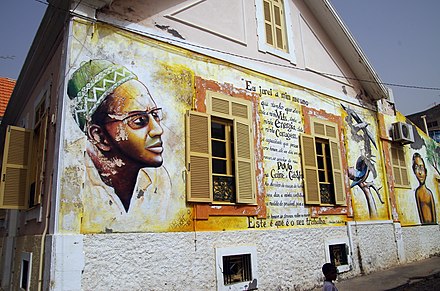Murals and graffiti
Murals and graffiti
Graffiti redirects here. For Wikivoyage's graffiti wall, see Wikivoyage:Graffiti wall Murals and graffiti are frequently encountered in urban environments.
Understand
 As long as mankind has been able to paint, people have been drawing and scribbling on surfaces. The oldest versions of these are thousands of years old, found inside caves and sometimes even listed as UNESCO World Heritage site. Later on, especially churches and other religious buildings were decorated with pictures, especially on the inside. Some cities employ murals for political propaganda or advertising while others hope to take advantage of a "code of honor" that some graffiti sprayers feel bound by, not to spray on the work of another. Regardless of the reason, such murals can be beautiful and interesting to look at in their own right.
As long as mankind has been able to paint, people have been drawing and scribbling on surfaces. The oldest versions of these are thousands of years old, found inside caves and sometimes even listed as UNESCO World Heritage site. Later on, especially churches and other religious buildings were decorated with pictures, especially on the inside. Some cities employ murals for political propaganda or advertising while others hope to take advantage of a "code of honor" that some graffiti sprayers feel bound by, not to spray on the work of another. Regardless of the reason, such murals can be beautiful and interesting to look at in their own right.
Unwanted murals or scribbles are known as graffiti. While graffiti is far from being only a modern phenomenon, most people probably associate it with youth vandalizing public and private property using spray paint. However, nowadays there are established graffiti artists, graffiti events and "legal" walls. Graffiti paintings in this context often resemble artworks rather than illegible tags. In times and at places when literacy was widespread, graffiti would often include identifiable words or even consist entirely of words. The best known modern example are perhaps the more ephemeral scribblings on the walls of public toilet stalls. As such graffiti are not much "filtered" by laws or the wishes of the ruling classes, they can - if preserved - give glimpses into the life of ordinary people in bygone times. Ancient Roman graffiti (for example those found in Pompeii) in particular provide insights into pronunciation (through their misspellings) as well as the mood of the times and the sometimes crude humor of the "common people".
Destinations

- Belfast is world famous for its political murals, supporting both the nationalist and loyalist sides in the Northern Irish conflict.
- In Alpine countries you may find houses decorated with, say, people in traditional clothing, flowers or landscapes.
- The Painted Monasteries of Bukovina and other religious buildings around the world.
- Mexico City has a long tradition of murals, particularly from the 1920s through 1950s, when the government supported the Mexican Mural Movement providing public buildings as canvases for some of Mexico's most famous artists of the modern era
- The Berlin Wall no longer stands, but pieces and parts of it have been saved and put on display in the city itself and elsewhere. On them you can see graffiti and paintings, or at least part of them.
- Many of the walls in the "free town" of Christiania are covered by colourful murals.
- The Mission District of San Francisco is well-known for its murals in alleys.
- The center of Łódź is famous in Poland for its numerous murals, which keep on appearing with the support of the local government and are ingrained in the local community's life.
- Melbourne has several alleys in the CBD that are designated for graffiti.
- New York City is well-known as one of the world's major centers of graffiti culture
- London is known for its graffiti culture, particularly in East London
- Chicago's Pilsen neighborhood, with its large Mexican-American population, is known for have a large number of Mexican-inspired graffiti.
- Nicaragua has a pre-Columbian tradition of petroglyphs that was expanded upon and revived in the Sandinista era (1979-1990) for political purposes. As the Sandinistas are in power again since 2006, political murals make no sign of going away any time soon. If you are in León or Estelí make sure to check them out, as they are particularly plentiful in those Sandinista strongholds.
- Yeldeğirmeni on the Asian Side of Istanbul has the largest collection of murals in the city.
Stay safe
Sometimes notable graffiti and murals are used by street gangs to mark their "territory". Going on a photo hunt for such artworks, particularly without someone familiar with the area, can be extremely dangerous.
See also
- Modern and contemporary art
- Signs
- Urban rail — where you often can find both legal and illegal paintings
- Urbex